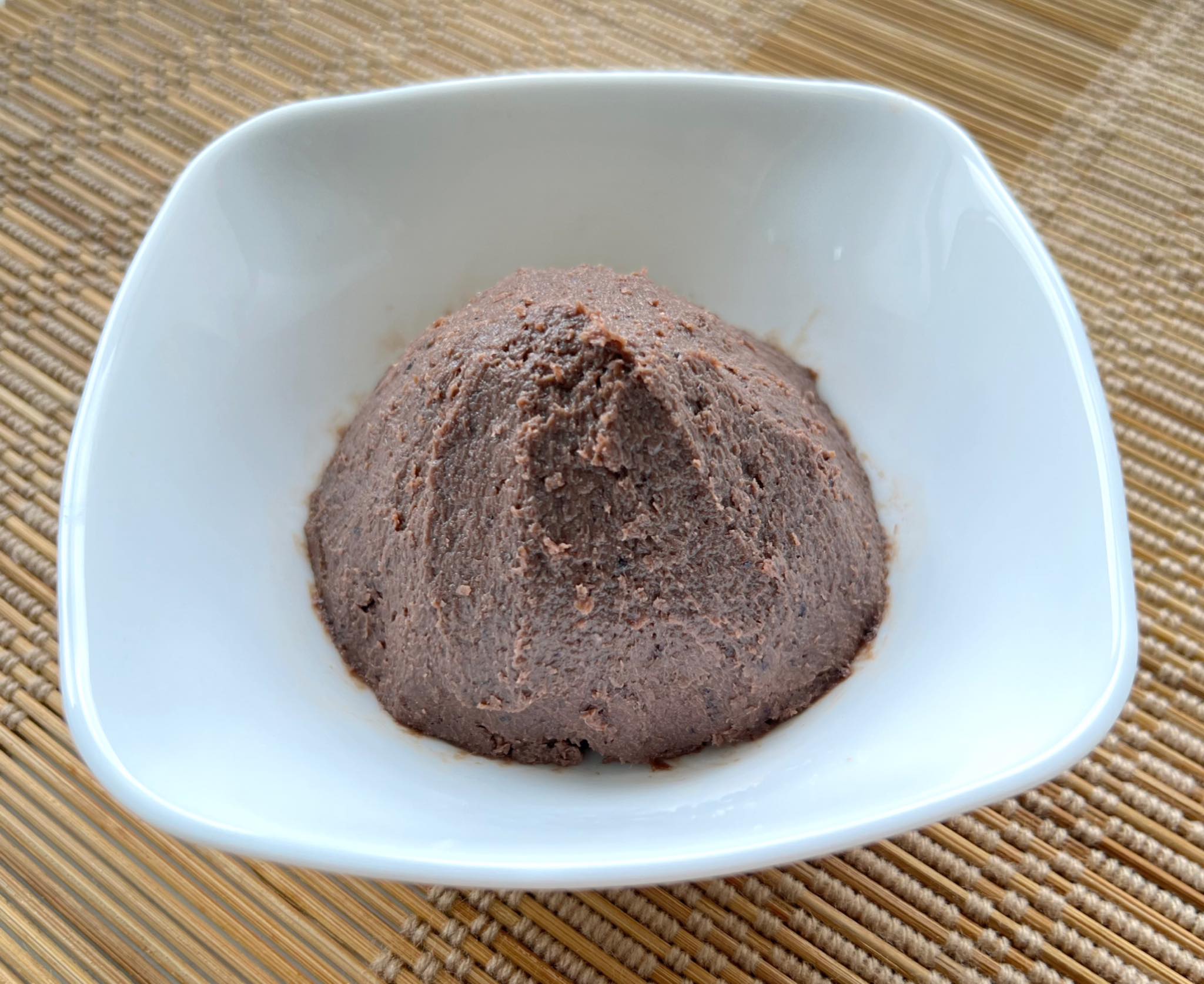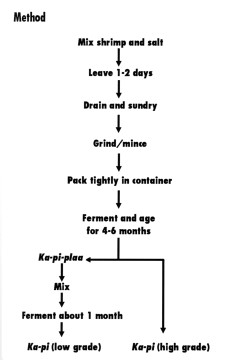Ka-pi
- Name (Thai)
- กะปิ
- Name (English)
- Fermented shrimp paste
- Local name
- Ka-pi-koong Koei-koong
- Fish normally used
-
Acetes erythraeus (Koei-dtaa-daeng)
Acetes sp. (Koei-malet-khao-saan-som-oh)
Mesopodopsis orientalis (Koei-dtaa-dam)
- Product
- Fishery
- Ingredients
- Planktonic and semi-planktonic saltwater or brackish water shrimp. Salt.
- Fermentation
- 4-6 months.
- Storage life
- 12-18 months, depending on the amount of salt used, but not more than 2 years.
- Microorganisms
-
Bacillus amyloliquefaciens
Reference Control of Listeria monocytogenes on sliced bologna sausage using a novel bacteriocin, amysin, produced by Bacillus amyloliquefaciens isolated from Thai shrimp paste (Kapi) DOI 10.1016/j.foodcont.2013.01.012 Year 2013 Bacillus flexusReference Identification and lipolytic activity of Bacillus and Staphylococcus strains from shrimp paste (Ka-pi) DOI 10.7324/JAPS.2019.90404 Year 2019 Bacillus infantisReference Identification and lipolytic activity of Bacillus and Staphylococcus strains from shrimp paste (Ka-pi) DOI 10.7324/JAPS.2019.90404 Year 2019 Bacillus licheniformisReference The traditional fermented foods of Thailand ISBN 9679932249 Year 1995 Bacillus paramycoidesReference Identification and lipolytic activity of Bacillus and Staphylococcus strains from shrimp paste (Ka-pi) DOI 10.7324/JAPS.2019.90404 Year 2019 Bacillus sp.Reference Identification and lipolytic activity of Bacillus and Staphylococcus strains from shrimp paste (Ka-pi) DOI 10.7324/JAPS.2019.90404 Year 2019 Reference The traditional fermented foods of Thailand ISBN 9679932249 Year 1995 Bacillus sphaericusReference The traditional fermented foods of Thailand ISBN 9679932249 Year 1995 Bacillus tequilensisReference Identification and lipolytic activity of Bacillus and Staphylococcus strains from shrimp paste (Ka-pi) DOI 10.7324/JAPS.2019.90404 Year 2019 Corynebacterium sp.Reference The traditional fermented foods of Thailand ISBN 9679932249 Year 1995 Lactobacillus sp.Reference The traditional fermented foods of Thailand ISBN 9679932249 Year 1995 Micrococcus sp.Reference The traditional fermented foods of Thailand ISBN 9679932249 Year 1995 Pediococcus halophilusReference The traditional fermented foods of Thailand ISBN 9679932249 Year 1995 Staphylococcus aureusReference The traditional fermented foods of Thailand ISBN 9679932249 Year 1995 Staphylococcus cohnii subsp. urealyticusReference Identification and lipolytic activity of Bacillus and Staphylococcus strains from shrimp paste (Ka-pi) DOI 10.7324/JAPS.2019.90404 Year 2019 Staphylococcus epidermidisReference The traditional fermented foods of Thailand ISBN 9679932249 Year 1995 Staphylococcus sp.Reference The traditional fermented foods of Thailand ISBN 9679932249 Year 1995 Virgibacillus halodenitrificansReference Virgibacillus halodenitrificans MSK-10P, a Potential Protease-producing Starter Culture for Fermented Shrimp Paste (kapi) Production DOI 10.1080/10498850.2019.1652874 Year 2019 - Properties
- Ka-pi is a dark-coloured strong smelling paste. The colour varies slightly depending on the raw materials used. Ka-pi from Koei-dtaa-daeng has a pinkish purple colour and that from Koei-dtaa-dam has dark purple colour. Ka-pi possesses a characteristic flavour at the time of ripening, which varies for each batch. A low salt mixture results in 20.5% salt as sodium chloride and it should be eaten within 1 year of making into paste. For Ka-pi with a salt content of 30.5% the right time to eat is after 14-16 months of maturing and the characteristic flavour is gradually lost after 18 months. The flavour of Ka-pi is considered as an indicator of its quality. Fish paste (Ka-pi-plaa) is not popular among consumers, so it is mixed with shrimp paste to make a cheaper and lower quality product. In the market it is not always possible to tell whether the Ka-pi is pure shrimp paste or not as the sellers don't like to show that it is low quality, but a low price should indicate low quality.
- Method
- Step 1: Wash the shrimp and gently mix with about 15-30% of sea salt by tossing in a bamboo basket. Keep the mixture in either a bamboo basket or a wooden vat for 1-2 days, after which the contents are drained of liquid and spread on a bamboo mat to sundry. The liquid drained off can be further used to make fish sauce. The shrimp is partially dried at this stage with about 70% loss in weight. Step 2: Pound the mixture or mince it to a paste until it becomes sticky, similar to kneaded bread dough. Packed it tightly in wide-mouthed earthenware jars or wooden vats. Usually the paste is packed above the rim of the container into a dome shape to allow liquid to flow off, and loosely covered with cloth or betel palm leaf sheaths. Leave the paste to ferment and age at least 4 months if a low proportion of salt is used and 6 months if a high proportion is used until the Ka-pi is matured. At this period the paste gradually changes from soft to hard texture and the characteristic flavour is maintained for about 18 months.
- Production
- Home industry in the East and South.
- Consumption
- As Ka-pi has high salt content it is not eaten alone. It is used in various spicy soups or for flavouring dishes. Ka-pi-kooa is a spicy paste made by pounding Ka-pi with various ingredients such as chilli, galingale, lemongrass, shallots, garlic and kaffir lime peel. This mixture is used to make soups. Another main use is to make a condiment called Nam-prik for which Ka-pi is mixed with garlic, bird's eye chilli, and lime juice or tamarind. The ingredients vary according to local practice and taste. Nam-prik is popular for dipping vegetables in to eat with rice. Ka-pi is also cooked with fried rice.


